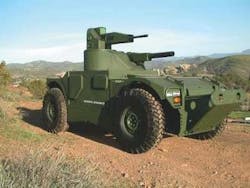Electronics ruggedization a key part of Objective Force Warrior program
By Ben Ames
FALLS CHURCH, Va. — Researchers at the U.S. Army say the 21st century soldier will be much more lethal, survivable, and networked than today's serviceman; he will be "an F-16 on legs."
They plan to demonstrate this Objective Force Warrior by 2006, and deploy it to battlefields by 2010.
null
That vision drew a step closer to reality on June 12 when Army planners named General Dynamics of Falls Church, Va., as the lead technology integrator for the project.
The $100 million award is phase two of the Army's plan to draw on dozens of private companies and military labs for innovative components. In fact, the Objective Force Warrior (OFW) pushes current technology so hard that it can use almost no commercial-off-the-shelf (COTS) parts, says Ginny Site, a General Dynamics representative.
Chief among those challenges is designing a portable power source to drive the sensors, communications, and data networks that will tie all the OFW components into other battlefield resources, Site says.
Over the next 25 months, General Dynamics engineers must design a complete prototype. They face a tough challenge — that design includes so many layers of technology that Army planners call it a "system of systems."
Company designers will begin by narrowing the field of almost 20 suppliers that they used in the first phase — an 18-month race between General Dynamics and Exponent of Menlo Park, Calif., to refine the OFW concept. General Dynamics planners will decide whether to keep those suppliers or bring on new ones, she says.
The final members will work together at Eagle Enterprise, a General Dynamics business unit with offices in Owings Mills and Westminster, Md. If the team succeeds in this job, it may win the phase three grant, a $41 million, 15-month push to demonstrate 25 more prototypes. The final phase is a $1 billion to $3 billion, 10-year effort to produce the complete system.
They have their work cut out for them. Most of the technologies that will make OFW work are still just sketches on drawing boards today, says Jean-Louis "Dutch" De Gay, an equipment specialist in the Objective Force Warrior Technology Program Office at the Army's Natick Soldier Center in Natick, Mass. That office dictates specifications for the program and awards the development contracts.
COTS components could help lower costs, but designers say they are concerned about the components' durability, De Gay says. "The problem is always ruggedization; they break down very quickly in a combat environment."
That would be a serious problem for the complex OFW system. Soldiers will carry integrated computers, global positioning systems, friend-or-foe identification, biometric monitors, built-in tourniquets, chemical and biological warfare suits, and cooling systems under their bulletproof vests.
The OFW helmet unites all these units, acting as a command and control platform with its own sensors, antenna, and three-dimensional battlefield-awareness view.
"The OFW in the field will be very similar to your laptop in the office," De Gay explains. "A soldier will plug into a local-area network or a wide-area network, so he can talk to every sensor on the battlefield."
De Gay says he agrees that battery power is the biggest hurdle for this plan.
"We are about at the chemical limit of what batteries can do, so now we're looking at hybrid systems," he says. "We're borrowing technology from fuel cells used in automobiles, adding solar panels that are woven into textiles or built into the helmet, and harvesting body heat and the energy from kinetic heel strikes."
Part of the solution to the power problem is the proximity of OFW soldiers to mechanized platforms. Army officials say the OFW data platform must link to its Future Combat Systems (FCS) plan for robotic cargo transporters, networked sensor fields, and unmanned air vehicles, as well as to all C4ISR (command, control, computer, communications, intelligence, surveillance, and reconnaissance) systems.
Modern soldiers often wear 120 pounds of equipment — everything they need to survive, De Gay says. But the OFW would deploy alongside a robotic infantry support system (RISS, aka mule) or robotic armored assault system (RAAS). So a solider will be able to return to his vehicle to replace or recharge batteries.
Another challenge is finding the best way to deploy the new troops. The OFW will be able to cover more ground and carry more weapons than standard soldiers. So commanders would need new strategies to use them in battle.
"It's like going to the racetrack," De Gay says. "Today's soldier is like a 1968 Volkswagen bug. But if we take that soldier and kit him out in full OFW gear, now we're putting a Lamborghini Countash on the track."
Army planners know it is not always easy to deploy new technologies. Even after they had developed rifles that were accurate at long range, Civil War soldiers continued to fight like Revolutionary War soldiers, De Gay points out. "They were still standing 100 yards away shooting each other in the face, but they had weapons that gave them 200 or 300 yards of standoff. They didn't start to fight correctly with that new weapon system for 10 or 15 years."
U.S. Army labs working on technologies for the Objective Force Warrior
Army Research Institute in Alexandria, Va.
Army Research Lab in Adelphi, Md.
Communications and Electronic
Command at Fort Monmouth, N.J.
Defense Advanced Research Projects
Agency (DARPA) in Arlington, Va.
Natick Soldier Center in Natick, Mass.
Picatinny Arsenal in Dover, N.J.
Program Executive Office (PEO) Soldier at Fort Belvoir, Va.
Training and Doctrine Command at Fort Monroe, Va.
General Dynamics partners in phase 1 development of the Objective Force Warrior
A123Systems
Allied Aerospace
BAE Systems
Boston Dynamics
Foster-Miller Inc.
DRS Technologies, Inc.
General Dynamics Armament
and Technology
General Dynamics C4 Systems
General Dynamics Decision Systems
General Dynamics Land Systems
General Dynamics Robotics Systems
ITT Aerospace
John Northrop and Associates
Micro Analysis and Design
Omega Training Group, Inc.
Science Applications International
(SAI) Group
SRI International

